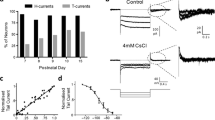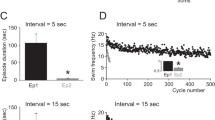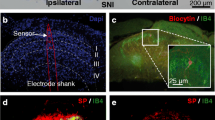Abstract
Motoneuron afterhyperpolarization (AHP) amplitude and somatic input conductance were monitored during pharmacologically induced, locomotorlike ventral root activity using an isolated neonatal rat spinal cord preparation (transected at the C1 level). Nonspontaneously firing motoneurons were selected for study. Single spikes were evoked at regular intervals by brief depolarizing current pulse injections, while somatic input conductance was monitored by hyperpolarizing current pulses. The induction of rhythmic ventral root activity was associated with tonic depolarization of motoneurons as well as superimposed rhythmically alternating membrane depolarization and hyperpolarization (locomotor drive potentials, LDPs). In 9 of 13 trials (six of eight cells) the peak amplitude of AHPs following current-evoked action potentials was reduced during both the hyperpolarized and the depolarized phases of the LDP, compared with the pre-locomotor condition. The peak AHP amplitude increased during the depolarized phase of the LDP in 4 of 13 trials (three of eight cells); however, in 3 of these 4 trials measurement of the AHP later in the course of its trajectory, using a half decay time (HDt) reference point, demonstrated AHP amplitude reduction during rhythmic activity compared with the prelocomotor condition. In seven of eight motoneurons the induction of rhythmic activity was associated with a decrease in input conductance. The pattern of AHP amplitude and conductance modulation during the two phases of the LDP was consistent for individual trials; however, there was considerable intertrial variation. The results suggest that AHP modulation during locomotor-like activity in this preparation can be mediated independently of supraspinal influences by intrinsic spinal cord mechanisms, and the observed AHP suppression does not appear to be the passive result of an increase in background conductance. The discrepancy between peak and HDt-based AHP amplitude measurements during the depolarized phase of the LDP in some trials may be due to competing effects of passively enhanced potassium currents and a mechanism that actively reduces the calcium-dependent potassium conductance. The possibility that both the AHP amplitude and the input conductance changes observed during locomotor-like activity reflect a regulation of potassium channels is discussed.
Similar content being viewed by others
References
Baldissera F, Gustafsson B (1970) Time course and potential dependence of the membrane conductance change during the afterhyperpolarization in the cat's alpha-motoneurones. Brain Res 17:365–368
Baldissera F, Gustafsson B (1971) Regulation of repetitive firing in motoneurones by the afterhyperpolarization conductance. Brain Res 30:431–434
Baldissera F, Gustafsson B (1974) Afterhyperpolarization conductance time course in lumbar motoneurones of the cat. Acta Physiol Scand 91:512–527
Barrett EF, Barrett JN (1976) Separation of two voltage-sensitive potassium currents, and demonstration of a tetrodotoxin-resistant calcium current in frog motoneurones. J Physiol (Lond) 255:737–774
Brownstone RM, Jordan LM, Kriellaars DJ, Noga BR, Shefchyk SJ (1992) On the regulation of repetitive firing in lumbar motoneurones during fictive locomotion in the cat. Exp Brain Res 90:441–455
Burke RE, Rudomin P (1977) Spinal neurons and synapses. In: Kandel ER (eds) Cellular biology of neurons. (Handbook of physiology, sect 1, The nervous system, vol I) American Physiological Society, Bethesda, MD, pp 877–944
Calvin WH, Schwindt PC (1972) Steps in the production of motoneuron spikes during rhythmic firing. J Neurophysiol 35:297–310
Carlson A, Falk B, Fuxe K, Hillarp NA (1964) Cellular localization of monoamines in the spinal cord. Acta Physiol Scand 60:112–119
Cazalets JR, Squalli-Houssaini Y, Clarac F (1992) Activation of the central pattern generators for locomotion by serotonin and excitatory amino acids in the neonatal rat. J Physiol (Lond) 455:187–204
Coombs JS, Eccles JC, Fatt P (1955) The electrical properties of the motoneurone membrane. J Physiol (Lond) 130:291–325
Eccles JC, Eccles RM, Lundberg A (1958) The action potentials of the alpha motoneurones supplying fast and slow muscles. J Physiol (Lond) 142:275–291
Fulton BP, Walton K (1986) Electrophysiological properties of neonatal rat motoneurones studied in vitro. J Physiol 370:651–678
Granit R, Kernell D, Shortess GK (1963a) Quantitative aspects of repetitive firing of mammalian motoneurones, caused by injected currents. J Physiol (Lond) 168:911–931
Granit R, Kernell D, Smith RS (1963b) Delayed depolarization and the repetitive response to intracellular stimulation of mammalian motoneurones. J Physiol (Lond) 168:890–910
Granit R, Kernell D, Lamarre Y (1966) Algebraical summation in synaptic activation of motoneurones firing within the “primary range” to injected currents. J Physiol (Lond) 187:379–399
Harada Y, Takahashi T (1983) The calcium component of the action potential in spinal motoneurones of the rat. J Physiol (Lond) 355:89–100
Hoffer JA, Sugano N, Loeb GE, Marks WB, O'Donovan MJ, Pratt CA (1987) Cat hindlimb motoneurons during locomotion. I. Normal activity patterns. J Neurophysiol 57:530–553
Hounsgaard J, Mintz I (1988) Calcium conductance and firing properties of spinal motoneurones in the turtle. J Physiol (Lond) 398:591–603
Hultborn H, Murakami F, Tsukahara N, Gustafsson B (1984) Afterhyperpolarization in neurones of the red nucleus. Exp Brain Res 55:333–350
Ito M, Oshima T (1962) Temporal summation of after-hyperpolarization following a motoneurone spike. Nature 195:910–911
Jordan LM (1983) Factors determining motoneuron rhythmicity during fictive locomotion. Symp Soc Exp Biol 37:423–444
Kernell D (1965a) High-frequency repetitive firing of cat lumbosacral motoneurones stimulated by long-lasting injected currents. Acta Physiol Scand 65:74–86
Kernell D (1965b) Synaptic influences on the repetitive activity elicited in cat lumbosacral motoneurones by long-lasting injected currents. Acta Physiol Scand 63:409–410
Kiehn O (1991) Plateau potentials and active integration in the “final common pathway” for motor behaviour. Trends Neurosci 14 (2):68–73
Krnjevic K, Puil E, Werman R (1978) EGTA and motoneuronal after-potentials. J Physiol (Lond) 275:199–223
Kudo N, Yamada T (1987) N-methyl-DL-aspartate-induced locomotor activity in a spinal cord-hindlimb muscles preparation of the newborn rat studied in vitro. Neurosci Lett 75:43–48
Malenka RC, Madison DV, Andrade R, Nicoll RA (1986) Phorbol esters mimic some cholinergic actions in hippocampal pyramidal neurons. J Neurosci 6(2):475–480
Meer DP, Buchanan JT (1992) Apamin reduces the late afterhyperpolarization of lamprey spinal neurons, with little effect on fictive swimming. Neurosci Lett 143:1–4
Newton BW, Hamill RW (1988) The morphology and distribution of rat serotonergic intraspinal neurons: an immunohistochemical study. Brain Res Bull 20:349–360
Rall W (1967) Distinguishing theoretical synaptic potentials computed for different soma-dendritic distributions of synaptic input. J Physiol (Lond) 30:1138–1168.
Schmidt BJ (1990) Modulation of afterhyperpolarization amplitude in lumbar motoneurons during fictive locomotion in the rat spinal cord in vitro. Soc Neurosci Abstr 16:492.
Schwindt PC, Calvin WH (1973) Equivalence of synaptic and injected current in determining the membrane potential trajectory during motoneuron rhythmic firing. Brain Res 59:389–394
Schwindt P, Crill W (1980) Role of a persistent inward current in motoneuron bursting during spinal seizures. J Neurophysiol 43:1296–1318
Schwindt PC, Crill WE (1982) Factors influencing motoneuron rhythmic firing results from a voltage-clamp study. J Neurophysiol 48:875–889
Shapovalov AI (1972) Extrapyramidal monosynaptic and disynaptic control of mammalian alpha-motoneurons. Brain Res 40:105–115
Shapovalov AI, Kurchavyi GG, Strogonov MP (1966) Synaptic mechanisms of vestibulospinal influences on alpha-motoneurons. Fiziol Zh SSSR 52:91–100
Smith JC, Feldman JL (1987) In vitro brainstem-spinal cord preparations for study of motor systems for mammalian respiration and locomotion. J Neurosci Methods 21:321–333
Smith JC, Feldman JL, Schmidt BJ (1988) Neural mechanisms generating locomotion studied in mammalian brainstemspinal cord in vitro. FASEB J 2:2283–2288
Takahashi M (1990) Membrane currents in visually identified motoneurones of neonatal rat spinal cord. J Physiol (Lond) 423:27–46
Van Dongen PAM, Grillner S, Hokfelt T (1986) 5-Hydroxytryptamine (serotonin) causes a reduction in the afterhyperpolarization following the action potential in lamprey motoneurons and premotor interneurons. Brain Res 366:320–325
Wallen P, Buchanan JT, Grillner S, Hill RH, Christenson J, Hokfelt T (1989) Effects of 5-hydroxytryptamine on the afterhyperpolarization, spike frequency regulation, and oscillatory membrane properties in lamprey spinal cord neurons. J Neurophysiol 61:759–768
Walton K, Fulton BP (1986) Ionic mechanisms underlying the firing properties of rat neonatal motoneurons studied in vitro. Neuroscience 19:669–683
Zajac FE, Young JL (1980) Discharge properties of hindlimb motoneurons in decerebrate cats during locomotion induced by mesencephalic stimulation. J Neurophysiol 43:1221–1235
Zieglgänsberger W, Reiter Ch (1974) A cholinergic mechanism in the spinal cord of cats. Neuropharmacology 13:519–527
Author information
Authors and Affiliations
Rights and permissions
About this article
Cite this article
Schmidt, B.J. Afterhyperpolarization modulation in lumbar motoneurons during locomotor-like rhythmic activity in the neonatal rat spinal cord in vitro. Exp Brain Res 99, 214–222 (1994). https://doi.org/10.1007/BF00239588
Received:
Accepted:
Issue Date:
DOI: https://doi.org/10.1007/BF00239588




